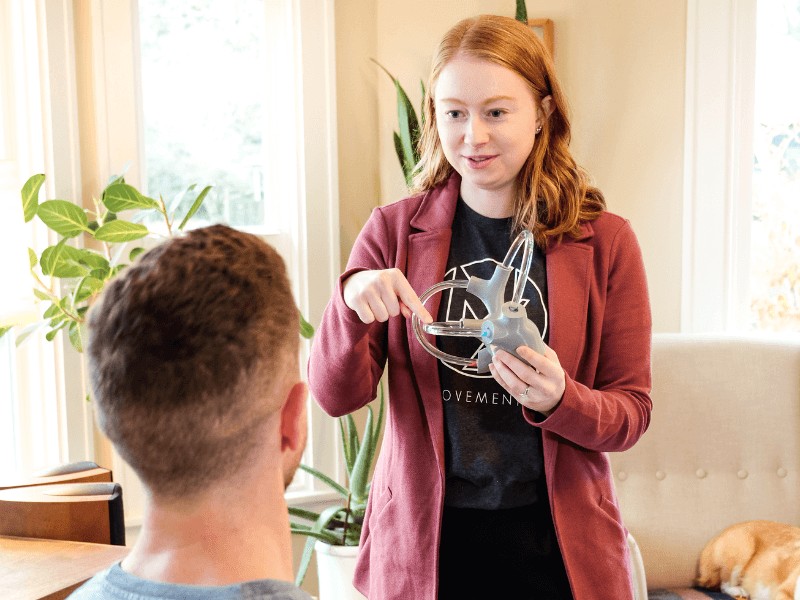Shoulder Impingement Treatment
Shoulder impingement is a common yet often misunderstood condition that affects a wide range of individuals, from athletes to office workers. It’s characterized by pain and discomfort in the shoulder, often exacerbated by certain movements. Understanding this condition is crucial, not only because of its prevalence but also due to its potential impact on daily activities and quality of life.
Recent studies suggest that shoulder issues, including impingement, are widespread. According to a report in the Journal of Orthopaedic & Sports Physical Therapy, shoulder pain affects up to 26% of adults at some point in their lives. What makes shoulder impingement particularly noteworthy is its ability to limit range of motion and weaken shoulder strength, directly impacting one’s ability to perform everyday tasks.
The relevance of this condition to our daily lives cannot be overstated. Whether it’s reaching for a high shelf, playing a favorite sport, or simply getting dressed, the shoulder plays a pivotal role in many of our daily activities. An impinged shoulder can turn these simple actions into challenging ordeals. Furthermore, without proper understanding and treatment, shoulder impingement can lead to more serious conditions, such as rotator cuff injuries.
This article aims to demystify shoulder impingement, offering clear, evidence-based insights into its causes, symptoms, and most importantly, the various treatment strategies. We will delve into how physical therapy plays a pivotal role in managing and recovering from this condition. By the end of this read, you’ll have a comprehensive understanding of shoulder impingement and be equipped with knowledge on how to effectively approach its treatment. Whether you’re experiencing shoulder pain or are interested in preventive strategies, this article will serve as a valuable guide in your journey towards better shoulder health.
What is Shoulder Impingement?
Shoulder impingement is a condition that can significantly affect an individual’s quality of life and physical functionality. This condition occurs when the tendons of the rotator cuff muscles become irritated and inflamed as they pass through the subacromial space, the narrow passage beneath the acromion, which is part of the shoulder blade. With repeated movement, these tendons can be ‘impinged’ or pinched, leading to pain and restricted movement.
The impact of shoulder impingement on daily life can be considerable. It may manifest as difficulty in performing overhead activities, challenges in tasks requiring arm elevation, or discomfort during routine actions such as dressing or reaching. The condition can also hinder athletic performance, particularly in sports that involve substantial shoulder movement like swimming, tennis, or baseball.
Furthermore, shoulder impingement can lead to a progressive cycle of shoulder weakness and increased vulnerability to injury. This can escalate into chronic issues, including the deterioration of tendons, potentially resulting in a rotator cuff tear if left untreated. Thus, understanding and addressing shoulder impingement promptly is vital to maintaining shoulder health and overall physical well-being.
Symptoms of Shoulder Impingement
Recognizing the symptoms of shoulder impingement is a critical step towards seeking appropriate care and treatment. This condition can manifest in various ways, and symptoms may vary from person to person. While some individuals might experience mild discomfort, others may face more severe pain and functional limitations. It’s important to remember that these symptoms can potentially indicate shoulder impingement, but a definitive diagnosis should always be made by a healthcare professional like a physical therapist.
Here is a comprehensive list of symptoms frequently associated with shoulder impingement:
- Pain and Tenderness: One of the most common symptoms is a dull or sharp pain in the shoulder, which is often felt over the outer arm. This pain may intensify when reaching overhead, lifting objects, or lying on the affected shoulder.
- Reduced Range of Motion: Individuals may notice a decrease in their ability to move the shoulder, especially when performing actions such as reaching behind the back or extending the arm upwards.
- Weakness in the Shoulder: There might be a noticeable weakness in the shoulder muscles, making it difficult to perform everyday tasks that require lifting or carrying.
- Pain or Stiffness When Lifting the Arm: Pain is often experienced when lifting the arm to the side or in front, which is a movement commonly involved in many daily activities. Rotating the arm may also cause a pinching sensation.
- Clicking or Grinding Sensation: A clicking or grinding noise or sensation (known as crepitus) may be felt when moving the shoulder, especially in certain positions.
- Night Pain: Shoulder impingement can sometimes lead to discomfort or pain when sleeping, particularly when lying on the affected side.
- Radiating Pain: In some cases, the pain may radiate from the shoulder down the arm, although this is less common.
Remember, these symptoms can sometimes be indicative of other conditions, and not everyone with shoulder impingement will experience all of these symptoms. Early consultation with a healthcare provider is key to proper diagnosis and effective management of the condition.
Causes of Shoulder Impingement
While the exact cause of shoulder impingement can vary from individual to individual, there are several common risk factors and conditions frequently associated with its development. It’s important to note that these factors are not direct causes but can potentially increase the likelihood of experiencing shoulder impingement. Understanding these risk factors can be crucial in both prevention and management of the condition.
- Repetitive Overhead Activity: Engaging in activities or sports that involve repetitive overhead motion, such as swimming, tennis, or painting, can increase the risk of impingement by causing wear or stress on shoulder tissues.
- Age-Related Changes: As we age, our risk of shoulder impingement may increase. This is often due to age-related wear and tear of the shoulder tendons and muscles.
- Shoulder Instability: Those with unstable shoulders, either from previous injuries or inherent laxity, may be more susceptible to impingement as the humeral head can move abnormally within the joint.
- Muscle Weakness or Imbalance: Weakness or imbalance in the shoulder muscles, particularly the rotator cuff and the muscles that stabilize the scapula, can contribute to impingement. These conditions can lead to improper shoulder movement and increased risk of tendon irritation.
- Poor Posture: Chronic poor posture, especially with forward-rounded shoulders, can change the dynamics of the shoulder joint, potentially leading to impingement.
- Bone Spurs: Sometimes, bone spurs or overgrowths in the shoulder area can reduce the space available for the rotator cuff tendons, leading to impingement.
- Trauma or Injury: A history of shoulder trauma or injury, such as a fall or a sudden impact, can initiate a cascade of events that result in impingement syndrome.
- Occupational Hazards: Occupations that require heavy lifting or extensive use of the arms overhead can increase the likelihood of developing shoulder impingement.
It is important to remember that these factors can vary widely in their impact and do not guarantee the development of shoulder impingement. They provide a framework for understanding potential contributors to the condition, allowing for better preventive and treatment strategies.
Treatment Options for Shoulder Impingement
Effectively managing shoulder impingement often involves a multi-faceted approach, tailored to your specific needs and the severity of their condition. Here are various treatment options that are commonly employed:
- Physical Therapy: Physical therapy is a cornerstone in the treatment of shoulder impingement. It focuses on exercises to strengthen the shoulder, improve flexibility, and correct postural imbalances. Physical therapists who treat shoulder impingement may also use techniques like manual therapy, ultrasound, or electrical stimulation to reduce pain and inflammation.
- Medication: Over-the-counter pain relievers and anti-inflammatory medications, such as ibuprofen or naproxen, may sometimes help reduce pain and swelling. We recommend talking with your physician before starting any medication regimen.
- Corticosteroid Injections: For more severe cases, corticosteroid injections into the shoulder can provide relief from pain and inflammation. However, these are typically used sparingly, as overuse can weaken shoulder tendons.
- Ice and Heat Therapy: Applying ice packs to the shoulder can help reduce swelling and pain, particularly after activity. Heat therapy can also be beneficial, especially for relaxing tight muscles around the shoulder.
- Alternative Therapies: Some individuals find relief through alternative therapies such as acupuncture, yoga, or chiropractic care, although these should be considered supplementary to more traditional treatments.
It’s important to note that the choice of treatment should be based on individual assessment and consultation with healthcare professionals. Among these options, physical therapy plays a particularly vital role, not only in alleviating symptoms but also in addressing the underlying causes of shoulder impingement. This can help prevent future episodes and improve overall shoulder health. In the following section, we’ll explore in more depth the benefits and specific strategies used in physical therapy for treating shoulder impingement.
How Physical Therapy can help with Shoulder Impingement
Physical therapy plays a pivotal role in the management and treatment of shoulder impingement, offering a personalized and holistic approach to recovery. Working with a skilled physical therapist can significantly improve outcomes, not only by alleviating symptoms but also by addressing the root causes of the condition.
One of the key aspects of physical therapy for shoulder impingement is the development of a customized exercise program. This program typically focuses on strengthening the muscles around the shoulder, particularly the rotator cuff and the scapular stabilizers. Strengthening these muscles helps to stabilize the shoulder joint, reducing the risk of further impingement. Additionally, physical therapists guide patients through exercises aimed at increasing flexibility and range of motion. This can include stretching exercises and movements that enhance joint mobility, crucial for restoring function and preventing stiffness.
Beyond exercise, physical therapists employ various hands-on techniques to reduce pain and inflammation. This may involve manual therapy, where the therapist uses their hands to mobilize the joints and soft tissues of the shoulder, helping to alleviate pain and improve movement. Modalities like ultrasound or electrical stimulation might also be used as part of the treatment plan, providing targeted pain relief and reducing muscle spasms.
Education is another critical component of physical therapy for shoulder impingement. Physical therapists work with patients to understand their condition and how various activities or lifestyle factors might impact their symptoms. This includes advice on posture correction, ergonomic adjustments at work or home, and strategies to avoid movements that might exacerbate the condition. By empowering patients with this knowledge, physical therapy not only addresses the current episode of impingement but also equips individuals with the tools needed to prevent future occurrences.
Our Top Exercises & Stretches for Shoulder Impingement
1. Scapular Retractions
- While sitting with good posture, slowly pull your shoulder blades back and slightly down, trying to make them touch in the middle of your back.
- Hold for 1-2 seconds and relax, letting your shoulders come back forward.
- Perform 2-3 sets of 10-15 repetitions, ensuring the movement is controlled and limiting your shoulders from “hiking” up towards your ears.
2. Doorway Stretch (Pec stretch)
- While standing in a doorway, rest a single forearm on door-frame about shoulder height.
- Slowly rotate your body away from the door-frame until you feel a light-to-moderate stretch across the front of your chest, holding for approximately 30 seconds.
- Perform exercise 3 times, ensuring no pain in the shoulder when performed.
3. Side-lying Shoulder External Rotation
- Lay on your side with your affected shoulder on top.
- With your arm at your side, bend your elbow to 90 degrees and rest hand on stomach.
- Slowly, with control, rotate your forearm up (like a windshield wiper) to a comfortable height. Pause for 1-2 seconds then relax your forearm back to your stomach.
- Perform 2-3 sets of 8-12 repetitions, ensuring the upper arm stays tight to your body.
- Key tip: Keep your elbow stable and tight at your side during the exercise. This will cause your forearm to look like a windshield wiper as it pivots up, and back down.
Disclaimer: While these three exercises can be effective for managing shoulder impingement, it’s crucial to consult with a MovementX physical therapist before starting any exercise program. A licensed therapist can provide a personalized assessment and ensure that the exercises are appropriate for your specific condition and fitness level. Remember, each individual’s case is unique, and what works for one person may not be suitable for another.
Preventing Shoulder Impingement
Preventing shoulder impingement involves a combination of lifestyle changes, exercise routines, and awareness of body mechanics. Here are some actionable tips and strategies that can help reduce the risk of developing shoulder impingement or prevent its recurrence:
- Improve Posture: Good posture is key in preventing shoulder impingement. Practice maintaining a neutral spine and avoid slouching or rounding the shoulders, especially when sitting for long periods. This helps to reduce the strain on the shoulder muscles and tendons.
- Strengthen Shoulder Muscles: Incorporating exercises that strengthen the rotator cuff and scapular stabilizer muscles can help support the shoulder joint. Stronger muscles provide better joint stability, reducing the likelihood of impingement.
- Regular Stretching: Incorporate stretching exercises into your daily routine to maintain flexibility in the shoulder. Focus on stretches that open up the chest and improve the range of motion in the shoulder.
- Ergonomic Workspaces: If you work at a desk, ensure your workspace is set up ergonomically. The top of your computer screen should be at eye level, and your arms should rest comfortably on the desk, reducing strain on the shoulders.
- Avoid Repetitive Overhead Activities: If your occupation or sport involves repetitive overhead movements, take frequent breaks and use proper techniques to reduce strain on the shoulder.
- Use Proper Techniques in Sports and Activities: If you engage in sports, especially those involving overhead movements like tennis or swimming, work with a coach to ensure you’re using proper techniques. This can help prevent excessive strain on the shoulder.
- Warm-Up Before Exercise: Always warm up properly before exercise or sports to prepare your muscles and joints. This can include light cardio and dynamic stretching.
- Listen to Your Body: Pay attention to your body’s signals. If you start experiencing shoulder pain or discomfort, don’t ignore it. Early intervention can prevent a minor issue from becoming a more serious problem.
By incorporating these preventative strategies into your daily life, you can significantly reduce the risk of shoulder impingement. Remember, prevention is often the best treatment.
Conclusion
As we’ve explored the complexities of shoulder impingement, it’s clear that this condition can significantly impact your daily life and activities. But remember, understanding and addressing shoulder impingement is the first step towards recovery and regaining your full range of motion and strength.
Reflect on your own experiences as you read this article. Have you noticed any symptoms of shoulder impingement in your daily life? Are there activities or habits that might be contributing to shoulder discomfort? Recognizing these signs early can be crucial in preventing and effectively treating shoulder impingement.
If you’re experiencing shoulder pain, stiffness, or any symptoms that limit your movement, don’t wait for them to escalate. Seeking professional guidance can make a substantial difference in your recovery journey. At MovementX, we’re dedicated to helping you move better and live a life free of pain. Our skilled physical therapists are ready to work with you, offering personalized care that addresses your unique needs.
Don’t let shoulder impingement hold you back from enjoying your daily activities, sports, and a pain-free life. Request a session with MovementX today, and take the first step towards effective treatment and a healthier, more active future.
References
- Linaker CH, Walker-Bone K. Shoulder disorders and occupation. Best Pract Res Clin Rheumatol. 2015 Jun;29(3):405-23. doi: 10.1016/j.berh.2015.04.001. Epub 2015 May 8. PMID: 26612238; PMCID: PMC4836557.
- Umer M, Qadir I, Azam M. Subacromial impingement syndrome. Orthop Rev (Pavia). 2012 May 9;4(2):e18. doi: 10.4081/or.2012.e18. Epub 2012 May 31. PMID: 22802986; PMCID: PMC3395987.
- Sauers EL. Effectiveness of rehabilitation for patients with subacromial impingement syndrome. J Athl Train. 2005 Jul-Sep;40(3):221-3. PMID: 16284646; PMCID: PMC1250268.
- Donald J Hunter, Darren A Rivett, Sharmain McKeirnan, Lyn Smith, Suzanne J Snodgrass, Relationship Between Shoulder Impingement Syndrome and Thoracic Posture, Physical Therapy, Volume 100, Issue 4, April 2020, Pages 677–686, https://doi.org/10.1093/ptj/pzz182
-
-
About the Author
Dr. Romin Ghassemi is a physical therapist in Fuquay-Varina, North Carolina. He specializes in Orthopedic Conditions, Sports Injuries, and Neurological Conditions. Romin Ghassemi utilizes a variety of methods such as hands-on therapy, functional fitness, and mobilization to help you regain your strength, mobility, and vitality. Whether you’re an athlete recovering from an injury or just looking to enhance your overall well-being, he’s here to support you every step of the way!
Share This Page
More Conditions We Treat
Found this page interesting? Learn more about other conditions we treat:





